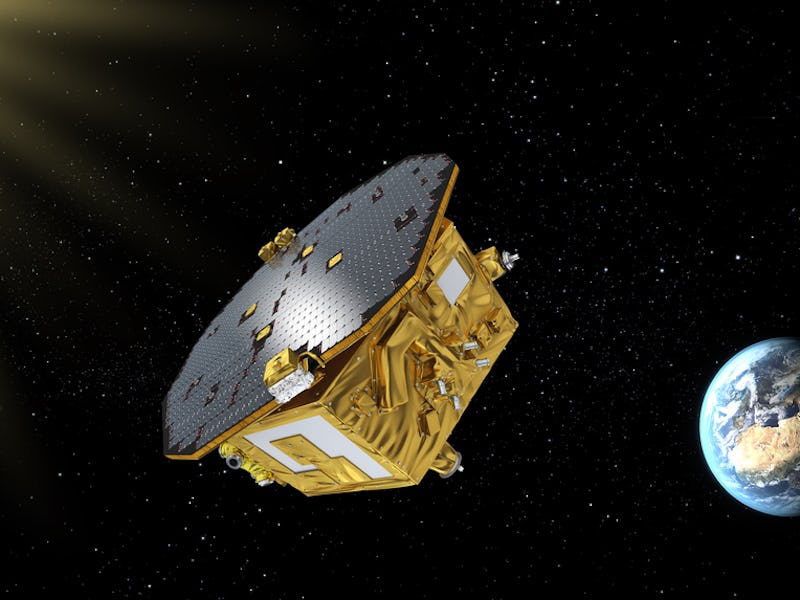LISA Spacecraft Completes Groundbreaking Gravitational Wave Observation Test
Scientists achieved free-fall in space, marking a milestone along the path toward the construction of a large-scale observatory.

The LISA Pathfinder mission could help us better understand meteors, asteroids, satellites, and the various other projectiles zipping around space at unimaginable speeds, but it has one primary goal: verifying the potential to observe and study gravitational waves moving through space. More than 900,000 miles away from Earth, the prototype spacecraft took one giant leap closer to that goal. In a new paper published in Physical Review Letters, the LISA team reveals that LPF’s free-falling tests were a groundbreaking success, exceeding initial expectations and acting with a precision that is more than five times better than originally required.
When the European Space Agency finally launched the state-of-the-art spacecraft last December, we knew next-to-nothing about gravitational waves — other than having a really good hunch that these ripples in spacetime first hypothesized by Albert Einstein at least existed. Then scientists actually found gravitational waves — using a pair of ultra-sensitive instruments here on the surface of the Earth to detect the very faint gravitational wave signals that had been produced by a pair of massive black holes colliding into one-another.
The LIGO discovery was a boon to the LISA project since it established that gravitational waves were indeed observable. Of course, LIGO’s discovery was something of a “right place in the right time” kind of incident. To truly study gravitational waves and allow ourselves a glimpse into what the universe looks like beyond the electromagnetic spectrum, we need to be able to observe these kind of signals at low frequencies — maybe as low as 0.1 Hz. That means you need a system that observes tiny flickers in spacetime over distances as large as a million miles, without interference from seismic, thermal, or terrestrial activity. That’s not going to happen on Earth.
The LISA Technology Package (LTP) is the scientific heart of the mission. It measures and controls the near-perfect free fall of two test masses in their vacuum chambers.
Einstein predicted the presence of gravitational waves when he developed his theory of relativity. “One century later, we are here paving the way for the first large scale gravitational wave observatory in space,” Fabio Favata, the head of the coordination office for ESA’s science directorate, told reporters at a news conference Tuesday. Because gravitational waves move through the universe unimpeded, they give scientists a cosmological view of the world that is transparent. Favata likened gravitational waves to the sounds of the forest that provide clues on what exists in the between the dense thickets of plants of trees — heard but unseen. The instruments used to find gravitational waves are the microphones that help us to listen in on those sounds.
What exactly can gravitational waves help show us about the universe? Although there is hope those signals can help us in better characterizing stellar populations in galactic regions, the major advantage would be in helping to better understand black holes. Trapping everything in its vicinity including light, black holes are an extremely mysterious phenomenon that astrophysicists know little about. Gravitational waves could finally provide the kind of information we need to assess a more complete view of what a black hole looks like, how it behaves, how it evolves, etc.
That’s why the latest results for the LISA Pathfinder mission are so important. In an ideal scenario, scientists would detect gravitational waves in space by launching two or more objects into space and keeping them separated by hundreds of thousands or even millions of miles, and firing a laser between those objects that’s capable of picking up on very faint signals like gravitational waves.
A project like this would require an enormous amount of time and resources, so you need to prove the concept first before you can actually begin the experiment itself. ESA scientists basically shrunk that concept down into a single spacecraft — LISA Pathfinder. Contained within the spacecraft are two two-kilogram gold-platinum masses which were released into a vacuum chamber in February, with first day of operation starting on March 1. The objects are way too close to one-another for a gravitational wave to be measured, but the LISA Pathfinder environment does allow scientists to determine whether it’s possible for these objects to achieve perfect free fall in which their movement is only controlled by gravity. A large scale observatory would need the same kind of validation — that external forces would not exhibit undue gravitational influence on the objects.
LISA Pathfinder measured the relative acceleration between the two objects using a laser interferometer that could detect changes at the scale lower than ten millionths of a billionth of Earth’s gravitational acceleration — which corresponds to the weight of a virus on Earth. Here’s what’s even crazier: Interfering “noise” measured by the spacecraft was 100 times lower than what ESA scientists expected. The ability to measure true free-fall is a key milestone towards large-scale gravitational wave study in outer space, and now puts the LISA project on a shorter path towards the ultimate goal of building and launching a gravitational wave observatory.
ESA has put forward a 2034 launch year for a large-scale gravitational wave observatory. Lasers would measure fluctuations in objects separated by millions of miles in three spacecraft housed in a triangular fashion.
The proposed LISA mission will detect gravitational waves in space using a trio of satellites, separated by millions of kilometers.